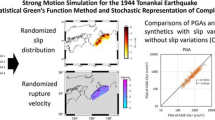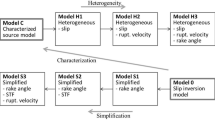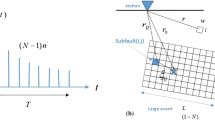Abstract
A generalization of the stochastic summation scheme of small earthquakes following a general form of the source spectrum (ω−n) model is developed to estimate the proper probability density functions for rupture propagation over the fault and to simulate site-specific strong ground motions in two independent stages. The probability density functions for rupture propagation are first developed for a single-corner-frequency source model, and then extended to multiplicative and additive double-corner-frequency source models to partially account for the effects of finite-fault rupture such as fault geometry, rise time, and rupture time on ground motions, and to better match observed Fourier amplitude spectra (FAS). The generalized two-stage stochastic summation scheme developed in this study can be used to simulate realistic strong-ground-motion time histories from small events, represented as empirical Green’s functions (EGFs), by specifying only two source parameters of the seismic moment and stress drop for a given site. The proposed two-stage stochastic summation schemes are tested using numerical examples following the theoretical source models as well as observed ground motions of the 2011 Mw 9.0 Tohoku earthquake in Japan and the 1994 Mw 6.7 Northridge earthquake in California to verify the applicability of the approach. Comparisons between the observed and simulated time histories for these two earthquakes, their response spectra, and FAS show satisfactory performance of the proposed approach for engineering purposes. The results of these comparisons indicate that the proposed stochastic summation of small events as EGFs can adequately replicate observed ground motions and evaluate uncertainties in ground motions with the generation of many time history realizations corresponding to a multitude of possible rupture processes . The proposed approach can also be used to generate multiple realistic acceleration time histories matched on average to the target response spectra for use in earthquake performance design, and to develop ground-motion models for low-seismicity regions, where there is a lack of recording of strong ground motions.








Similar content being viewed by others
References
Aki, K. (1967). The scaling law of seismic spectrum. Journal of Geophysical Research, 72, 1217–1231.
Aki, K., & Richards, P. G. (2002). Quantitative seismology (2nd ed.). Sausalito: University Science Books.
Allmann, B. P., & Shearer, P. M. (2009). Global variations of stress drop for moderate to large earthquakes. Journal of Geophysical Research, 114(B01), 310.
Archuleta, R. J., & Ji, C. (2016). Moment rate scaling for earthquakes 3.3 ≤ M ≤ 5.3 with implications for stress drop. Geophysical Research Letters, 43, 12005–12011.
Atkinson, G. (1993). Source spectra for earthquakes in eastern North America. Bulletin of the Seismological Society of America, 83, 1778–1798.
Atkinson, G. M., Assatourians, K., Boore, D. M., Campbell, K., & Motazedian, D. (2009). A guide to differences between stochastic point-source and stochastic finite-fault simulations. Bulletin of the Seismological Society of America, 99(6), 3192–3201.
Atkinson, G. M., & Boore, D. (1995). New ground motion relations for Eastern North America. Bulletin of the Seismological Society of America, 85, 17–30.
Atkinson, G. M., & Boore, D. M. (1998). Evaluation of models for earthquake source spectra in eastern North America. Bulletin of the Seismological Society of America, 88, 917–934.
Atkinson, G. M., & Silva, W. (2000). Stochastic modeling of California ground motions. Bulletin of the Seismological Society of America, 90, 255–274.
Atkinson, G. M., & Sonley, E. (2003). Ground-motions for the M 5.0 Au sable Forks earthquake. Seismological Research Letters, 74, 339–349.
Boatwright, J. (1988). The seismic radiation from composite models of faulting. Bulletin of the Seismological Society of America, 78, 489–508.
Boatwright, J. (1994). Regional propagation characteristics and source parameters of earthquakes in northeastern North America. Bulletin of the Seismological Society of America, 84, 1–15.
Boatwright, J., & Seekins, L. (2011). Regional spectral analysis of three moderate earthquakes in northeastern North America. Bulletin of the Seismological Society of America, 101, 1769–1782.
Boore, D. M. (1983). Stochastic simulation of high-frequency ground motions based on seismological models of the radiated spectra. Bulletin of the Seismological Society of America, 73, 1865–1894.
Boore, D. M. (2003). Simulation of ground motion using the stochastic method. Pure and Applied Geophysics, 160, 635–676.
Boore, D. M. (2009). Comparing stochastic point-source and finite-source ground-motion simulations: SMSIM and EXSIM. Bulletin of the Seismological Society of America, 99, 3202–3216.
Boore, D. M., Di Alessandro, C., & Abrahamson, N. A. (2014). A generalization of the double-corner-frequency source spectral model and its use in the SCEC BBP validation exercise. Bulletin of the Seismological Society of America, 104(5), 2387–2398.
Brune, J. N. (1970). Tectonic stress and the spectra of seismic shear waves from earthquakes. Journal of Geophysical Research, 75, 4997–5009.
Brune, J. N. (1971). Correction. Journal of Geophysical Research, 76, 5002.
Cotton, F., Archuleta, R., & Causse, M. (2013). What is sigma of the stress drop? Seismological Research Letters, 84(1), 42–48.
Courboulex, F., Vallée, M., Causse, M., & Chounet, A. (2016). Stress-drop variability of shallow earthquakes extracted from a global database of source time functions. Seismological Research Letters, 87(4), 912–918.
Dan, K., Watanabe, T., Tanaka, T., & Sato, R. (1990). Stability of earthquake ground motion synthesized by using different small-event records as empirical Green’s functions. Bulletin of the Seismological Society of America, 80, 1433–1455.
Eshelby, J. (1957). The determination of the elastic field of an ellipsoidal inclusion, and related problems. Proceedings of the Royal Society of London Series A, 241(1226), 376–396.
Evernden, J. F. (1977). Spectral characteristics of the P codas of Eurasian earthquakes and explosions. Bulletin of the Seismological Society of America, 67, 1153–1171.
Frankel, A. (1995). Simulating strong motions of large earthquakes using recordings of small earthquakes: the Loma Prieta mainshock as a test case. Bulletin of the Seismological Society of America, 85(4), 1144–1160.
Frankel, A. (2017). Modeling strong-motion recordings of the 2010 Mw 8.8 Maule, Chile, earthquake with high stress-drop subevents and background slip. Bulletin of the Seismological Society of America, 107(1), 372–386.
Frasier, C. W., & North, R. G. (1978). Evidence for w-cube scaling from amplitudes and periods of the Rat Island sequence (1965). Bulletin of the Seismological Society of America, 68, 265–282.
García, D., Singh, K., Herráiz, M., Pacheco, J., & Ordaz, M. (2004). Inslab earthquakes of Central Mexico: Q, source spectra, and stress drop. Bulletin of the Seismological Society of America, 94, 789–802.
Geller, R. J. (1976). Scaling relations for earthquake source parameters and magnitudes. Bulletin of the Seismological Society of America, 66, 1501–1521.
Ghofrani, H., Atkinson, G., Goda, K., & Assatourians, K. (2013). Stochastic finite-fault simulations of the 2011 Tohoku, Japan, earthquake. Bulletin of the Seismological Society of America, 103, 1307–1320.
Godano, M., Bernard, P., & Dublanchet, P. (2015). Bayesian inversion of seismic spectral ratio for source scaling: Application to a persistent multiplet in the western Corinth rift. Journal of Geophysical Research: Solid Earth, 120, 7683–7712.
Gusev, A. A. (1983). Descriptive statistical model of earthquake source radiation and its application to an estimation of short-period strong motion. Geophysical Journal of the Royal Astronomical Society, 74, 787–808.
Hanks, T. C., & McGuire, R. K. (1981). The character of high frequency strong ground motion. Bulletin of the Seismological Society of America, 71, 2071–2095.
Hartzell, S. H. (1978). Earthquake aftershocks as Green’s functions. Geophysical Research Letters, 5, 1–4.
Hartzell, S. H. (1982). Simulation of ground accelerations for the May 1980 Mammoth Lakes, California, earthquakes. Bulletin of the Seismological Society of America, 72, 2381–2387.
Hartzell, S. H., & Heaton, T. H. (1985). Teleseismic time functions for large shallow subduction zone earthquakes. Bulletin of the Seismological Society of America, 75, 965–1004.
Hashash, Y. M. A, Phillips, C., & D. R. Groholski. (2010). Recent advances in non-linear site response analysis. In International conferences on recent advances in geotechnical earthquake engineering and soil dynamics.
Hutchings, L. (1991). Prediction of strong ground motion for the 1989 Loma Prieta earthquake using empirical Green’s functions. Bulletin of the Seismological Society of America, 81, 88–121.
Hutchings, L. (1994). Kinematic earthquake models and synthesized ground motion using empirical Green’s functions. Bulletin of the Seismological Society of America, 84(4), 1028–1050.
Hutchings, L., & Viegas, G. (2012). Application of empirical Green’s functions in earthquake source, wave propagation and strong motion studies. In S. D’Amico (Ed.), Earthquake Research and Analysis-New Frontiers in Seismology (pp. 87–140). Rijeka: InTech. ISBN 978-953-307-840-3.
Hutchings, L., & Wu, F. (1990). Empirical Green’s functions from small earthquakes: waveform study of locally recorded aftershocks of the San Fernando earthquake. Journal of Geophysical Research, 95, 1187–1214.
Ide, S., Beroza, G. C., Shelly, D. R., & Uchide, T. (2007). A scaling law for slow earthquakes. Nature, 447, 76–79.
Irikura, K. (1983). Semi-empirical estimation of strong ground motions during large earthquakes. Bulletin of Disaster Prevention Research Institute (Kyoto University), 32, 63–104.
Irikura, K. (1986). Prediction of strong acceleration motion using empirical Green’s function. In Proceedings of the 7th Japan Earthquake Engineering Symposium, vol 151, pp. 151–156.
Jaimes, M. A., Reinoso, E., & Ordaz, M. (2008). Empirical Green’s functions modified by attenuation for sources located at intermediate and far distances from the original source. Journal of Earthquake Engineering, 12(4), 584–595.
Joyner, W. B. (1984). A scaling law for the spectra of large earthquakes. Bulletin of the Seismological Society of America, 74(4), 1167–1188.
Joyner, W. B., & Boore, D. M. (1986). On simulating large earthquakes by Green’s function addition of smaller earthquakes. In S. Das, J. Boatwright, & C. H. Scholtz (Eds.), Earthquake source mechanics (Vol. 37, pp. 269–274)., Maurice Ewing Series 6 Washington, D.C.: American Geophysical Union.
Kohrs-Sansorny, C., Courboulex, F., Bour, M., & Deschamps, A. (2005). A two-stage method for strong ground motions simulations using stochastic summation of small earthquakes. Bulletin of the Seismological Society of America, 95, 1387–1400.
Kurahashi, S., & Irikura, K. (2011). Source model for generating strong ground motions during the 2011 off the Pacific coast of Tohoku earthquake. Earth Planets Space, 63, 571–576.
Madariaga, R. (1976). Dynamics of an expanding circular fault. Bulletin of the Seismological Society of America, 66, 639–666.
Munguia, L., & Brune, J. N. (1984). Simulations of strong ground motion for earthquakes in the Mexicali-Imperial Valley region. Geophysical Journal International, 79, 747–771.
Niño, M., Ayala, G., & Ordaz, M. (2018). Ground-motion simulation by the empirical Green’s function method with a source defined by two corner frequencies and a two-stage summation scheme. Bulletin of the Seismological Society of America, 108(2), 901–912.
Nuttli, O. W. (1983). Average seismic source-parameter relations for mid-plate earthquakes. Bulletin of the Seismological Society of America, 73(2), 519–535.
Ordaz, M., Arboleda, J., & Singh, S. K. (1995). A scheme of random summation of an empirical Green’s function to estimate ground motions from future large earthquakes. Bulletin of the Seismological Society of America, 85, 1635–1647.
Sedaghati, F. (2018). Simulation of strong ground motions using the stochastic summation of small to moderate earthquakes as Green’s functions, Ph.D. Dissertation, The University of Memphis, Memphis, Tennessee.
Sedaghati, F., & Pezeshk, S. (2016). Estimation of the coda-wave attenuation and geometrical spreading in the New Madrid seismic zone. Bulletin of the Seismological Society of America, 106(4), 1482–1498.
Sedaghati, F., Pezeshk, S., & Nazemi, N. (2018). Site amplification within the Mississippi embayment of the central United States: Investigation of possible differences among various phases of seismic waves and presence of basin waves. Soil Dynamics and Earthquake Engineering, 113, 534–544.
Seyhan, E., & Stewart, J. P. (2014). Semi-empirical nonlinear site amplification from NGA-West2 data and simulations. Earthquake Spectra, 30(3), 1241–1256.
Shearer, P. M. (2017). Analysis of Southern California Seismicity Using: (1) Swarms as Transient Detectors, (2) Coda waves for Q Structure and Source Properties, USGS Final Technical Report, Award G16AP00148.
Singh, S. K., Iglesias, A., Ordaz, M., Perez-Campos, X., & Quintanar, L. (2011). Estimation of ground motion in Mexico City from a repeat of the M 7.0 Acambay Earthquake of 1912. Bulletin of the Seismological Society of America, 101(5), 2015–2028.
Tavakoli, B., Sedaghati, F., & Pezeshk, S. (2018). An Analytical effective point source-based distance conversion approach to mimic the effects of extended faults on seismic hazard assessment. Bulletin of the Seismological Society of America, 108(2), 742–760.
Tumarkin, A. G., & Archuleta, R. J. (1994). Empirical ground motion prediction. Ann. of Geofis., 37, 1691–1720.
Uchide, T., & Imanishi, K. (2016). Small earthquakes deviate from the omega-square model as revealed by multiple spectral ratio analysis. Bulletin of the Seismological Society of America, 106(3), 1357–1363.
Vallée, M. (2013). Source time function properties indicate a strain drop independent of earthquake depth and magnitude. Nature Communications, 4(1), 1–6.
Wennerberg, L. (1990). Stochastic summation of empirical Green’s functions. Bulletin of the Seismological Society of America, 80, 1418–1432.
Wu, F. T. (1978). Prediction of strong ground motion using small earthquakes. In Proceedings of 2nd international microzonation conference, vol 2, pp. 70l–704.
Wu, F. T. (1981). Ground motion prediction and Eastern U.S. Earthquake Monitoring, U.S. Geol. Surv. Open-File Rept. 81-944, pp. 1–6.
Yenier, E., & Atkinson, G. M. (2014). Equivalent point-source modeling of moderate-to-large magnitude earthquakes and associated ground-motion saturation effects. Bulletin of the Seismological Society of America, 104(3), 1458–1478.
Acknowledgements
We express our sincere appreciation to Martin Chapman, Chris Cramer, and Roger Meier for constructive suggestions on an early version of this paper. This project was supported by the Tennessee Department of Transportation.
Author information
Authors and Affiliations
Corresponding author
Additional information
Publisher's Note
Springer Nature remains neutral with regard to jurisdictional claims in published maps and institutional affiliations.
Electronic supplementary material
Below is the link to the electronic supplementary material.
Appendix
Appendix
This appendix explains how the user can generate random numbers with the probability distribution functions, p(t), proposed in this study. In this regard, the first step is to obtain the cumulative distribution function, P(t), as
where τ is time. Then, in the second step, a random number with the desired pdf, tj, is obtained from the inverse of cdf, P−1, as
in which uj is a random number with a uniform distribution in [0, 1].
When the cdf cannot be analytically derived, numerical integration is used instead. Note that because the proposed pdfs are symmetric, p(−t) = p(t) and P(−t) = 1 − P(t). The user can create a table of t and its corresponding P(t) with a sufficient time-step resolution instead of solving a parametric equation. Since the t − P(t) is constructed, its inverse function can be numerically obtained by finding the closest t satisfying u = P(t).
Three MATLAB functions “SCF_distribution.m”, “ADCF_distribution.m”, and “MDCF_distribution.m”, as well as a script with some examples, are provided as supplementary materials to generate random numbers following single-, additive double-, and multiplicative double-corner-frequency source models, respectively. In addition, the Python code is provided to produce random numbers and to replicate the numerical examples performed in this paper.
Rights and permissions
About this article
Cite this article
Sedaghati, F., Tavakoli, B. & Pezeshk, S. A Generalization of the Stochastic Summation Scheme of Small Earthquakes to Simulate Strong Ground Motions. Pure Appl. Geophys. 177, 3713–3732 (2020). https://doi.org/10.1007/s00024-020-02499-9
Received:
Revised:
Accepted:
Published:
Issue Date:
DOI: https://doi.org/10.1007/s00024-020-02499-9




